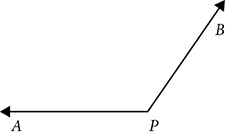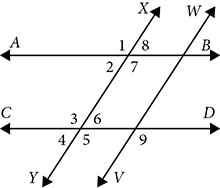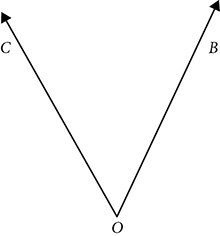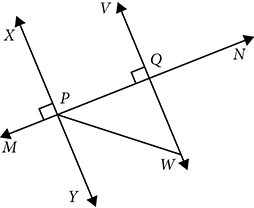REVIEW 1
Definitions, Constructions, Logic, and Proof
These review questions bring together the ideas from Chapters 1 and 2 and give you a chance to make sure you understand the vocabulary, have mastered construction techniques, and are learning how to build a logical proof. Answer all the questions, and try to express your thinking as clearly as you can.
1. What does it mean to bisect a segment?
2. Is it possible to bisect a line? Explain.
3. Under what circumstances is a conditional statement of the form p → q false?
4. Use a truth table to decide if ~p ∧ ~q is the negation of p ∨ q.
5. Bisect ∠APB using a compass and a straightedge.

6. Let p be the statement ΔABC is a right triangle, and let q be the statement  is the longest side of ΔABC. Write in words: p → (q ∨ ~q). Under what circumstance is the statement true? Explain your reasoning.
is the longest side of ΔABC. Write in words: p → (q ∨ ~q). Under what circumstance is the statement true? Explain your reasoning.
7. In the figure below,  . Find the measurement of ∠2 if m∠9 = 117°.
. Find the measurement of ∠2 if m∠9 = 117°.

8. Use a compass and a straightedge to copy ∠COB.

9. Is the inverse of a conditional statement p → q equivalent to ~( p → q)? Explain your reasoning.
10. Write the inverse of If ABCD is a rectangle, then ABCD is a parallelogram.
11. What does it mean to say that lines are perpendicular?
12.  are cut by transversal
are cut by transversal  at points P and Q, respectively. Is ∠APX ≅ CQX? What information is important for your decision?
at points P and Q, respectively. Is ∠APX ≅ CQX? What information is important for your decision?
13. Write the contrapositive of
If  connects the midpoint of side
connects the midpoint of side  to the midpoint of side
to the midpoint of side  in ΔABC, then
in ΔABC, then  is parallel to
is parallel to  and
and  half as long as
half as long as  .
.
14. Use a compass and a straightedge to construct an equilateral triangle.
15. Complete the truth table.

16. In the figure below,  and
and  are both perpendicular to
are both perpendicular to  .
.  bisects ∠YPQ. What can you conclude about ΔPQW? Explain.
bisects ∠YPQ. What can you conclude about ΔPQW? Explain.

17. Create a truth table for (p ∨ ~q) → (~p ∧ q).
18. Define parallel lines.
19. Is the argument below valid? Explain.
If a parallelogram is a rhombus, then the diagonals of the parallelogram are perpendicular to one another. The diagonals of parallelogram ABCD do not intersect to form right angles. Therefore, parallelogram ABCD is not a rhombus.
20. What are the two key terms introduced in the definition of circle and what information about the circle do they provide?